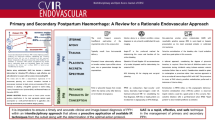Abstract
Objectives
To evaluate the efficacy of transcatheter arterial embolisation (TAE) using N-butyl-2-cyanoacrylate (NBCA) in the treatment of postpartum haemorrhage (PPH) due to ruptured pseudoaneurysm.
Methods
From March 2004 to December 2010, 33 patients underwent TAE using NBCA for massive PPH. Twenty-one patients (63.6 %) were in coagulopathic condition. Angiograms and medical records were retrospectively reviewed to determine technical/clinical success, complications and recurrent haemorrhage after TAE. Telephone interviews were conducted to obtain fertility-related data.
Results
Emergent angiograms revealed ruptured pseudoaneurysms at the uterine (n = 17), vaginal (n = 14), internal pudendal (n = 3) and obturator (n = 1) arteries, which were successfully embolised with NBCA. Four patients required additional embolisation of the uterine (n = 3) or ovarian artery (n = 1) with an absorbable gelatine sponge. Adequate haemostasis was achieved in 31 patients (93.9 %) after TAE. Two patients experienced persistent (n = 1) or recurrent (n = 1) haemorrhage, which required hysterectomy. There were no major embolisation-related complications. All 29 patients who were interviewed reported regaining of their regular menstruation. Nine patients had normal pregnancies and delivered healthy babies at full term.
Conclusions
TAE using NBCA is an effective treatment of PPH from ruptured pseudoaneurysms. In particular, NBCA is a potent embolic material in patients with coagulopathy. It does not seem to adversely affect future fertility.
Key Points
• Transcatheter arterial embolisation is a safe and effective treatment for postpartum haemorrhage.
• NBCA is potent embolic material to treat bleeding patients with severe coagulopathy.
• NBCA does not seem to adversely affect future fertility.

Similar content being viewed by others
References
Khan KS, Wojdyla D, Say L, Gulmezoglu AM, Van Look PF (2006) WHO analysis of causes of maternal death: a systematic review. Lancet 367:1066–1074
Pelage JP, Le Dref O, Mateo J et al (1998) Life-threatening primary postpartum hemorrhage: treatment with emergency selective arterial embolization. Radiology 208:359–362
Ganguli S, Stecker MS, Pyne D, Baum RA, Fan CM (2011) Uterine artery embolization in the treatment of postpartum uterine hemorrhage. J Vasc Interv Radiol 22:169–176
Park JK, Shin TB, Baek JC et al (2011) Failure of uterine artery embolization for controlling postpartum hemorrhage. J Obstet Gynaecol Res 37:971–978
Gonsalves M, Belli A (2010) The role of interventional radiology in obstetric hemorrhage. Cardiovasc Intervent Radiol 33:887–895
Berkane N, Moutafoff-Borie C (2010) Impact of previous uterine artery embolization on fertility. Curr Opin Obstet Gynecol 22:242–247
Matsubara S, Sato T, Nakata M (2011) Vaginal artery embolization with a permanent embolic agent for intractable postpartum hemorrhage. J Obstet Gynaecol Res 37:377–378
Kish JW, Katz MD, Marx MV, Harrell DS, Hanks SE (2004) N-butyl cyanoacrylate embolization for control of acute arterial hemorrhage. J Vasc Interv Radiol 15:689–695
Lee CW, Liu KL, Wang HP, Chen SJ, Tsang YM, Liu HM (2007) Transcatheter arterial embolization of acute upper gastrointestinal tract bleeding with N-butyl-2-cyanoacrylate. J Vasc Interv Radiol 18:209–216
Yoo DH, Jae HJ, Kim HC, Chung JW, Park JH (2012) Transcatheter arterial embolization of intramuscular active hemorrhage with N-butyl cyanoacrylate. Cardiovasc Intervent Radiol 35:292–298
Igarashi S, Izuchi S, Ishizuka B, Yoshimatu M, Takizawa K (2011) A case of pregnancy and childbirth after uterine artery embolization with a permanent embolic agent. Fertil Steril 95:290.e9–290.e11
Kanematsu M, Watanabe H, Kondo H et al (2011) Postpartum hemorrhage in coagulopathic patients: preliminary experience with uterine arterial embolization with N-butyl cyanoacrylate. J Vasc Interv Radiol 22:1773–1776
Kobayashi T, Terao T, Maki M, Ikenoue T (2001) Diagnosis and management of acute obstetrical DIC. Semin Thomb Hemost 27:161–167
Rady MY, Nightingale P, Little RA, Edwards JD (1992) Shock index: a re-evaluation in acute circulatory failure. Resuscitation 23:227–234
Cardella JF, Kundu S, Miller DL, Millward SF, Sacks D, Society of Interventional R (2009) Society of Interventional Radiology clinical practice guidelines. J Vasc Interv Radiol 20:S189–S191
Pelage JP, Soyer P, Repiquet D et al (1999) Secondary postpartum hemorrhage: treatment with selective arterial embolization. Radiology 212:385–389
Soyer P, Fargeaudou Y, Morel O, Boudiaf M, Le Dref O, Rymer R (2008) Severe postpartum haemorrhage from ruptured pseudoaneurysm: successful treatment with transcatheter arterial embolization. Eur Radiol 18:1181–1187
Heaston DK, Mineau DE, Brown BJ, Miller FJ Jr (1979) Transcatheter arterial embolization for control of persistent massive puerperal hemorrhage after bilateral surgical hypogastric artery ligation. AJR Am J Roentgenol 133:152–154
Vedantham S, Goodwin SC, McLucas B, Mohr G (1997) Uterine artery embolization: an underused method of controlling pelvic hemorrhage. Am J Obstet Gynecol 176:938–948
Pelage JP, Le Dref O, Jacob D et al (1999) Selective arterial embolization of the uterine arteries in the management of intractable post-partum hemorrhage. Acta Obstet Gynecol Scand 78:698–703
Sierra A, Burrel M, Sebastia C et al (2012) Utility of multidetector CT in severe postpartum hemorrhage. Radiographics 32:1463–1481
Acknowledgements
This study was supported by a grant of 03-2011-008 from the SNUBH Research Fund.
Author information
Authors and Affiliations
Corresponding author
Rights and permissions
About this article
Cite this article
Kim, G.M., Yoon, C.J., Seong, N.J. et al. Postpartum haemorrhage from ruptured pseudoaneurysm: efficacy of transcatheter arterial embolisation using N-butyl-2-cyanoacrylate. Eur Radiol 23, 2344–2349 (2013). https://doi.org/10.1007/s00330-013-2830-1
Received:
Revised:
Accepted:
Published:
Issue Date:
DOI: https://doi.org/10.1007/s00330-013-2830-1




